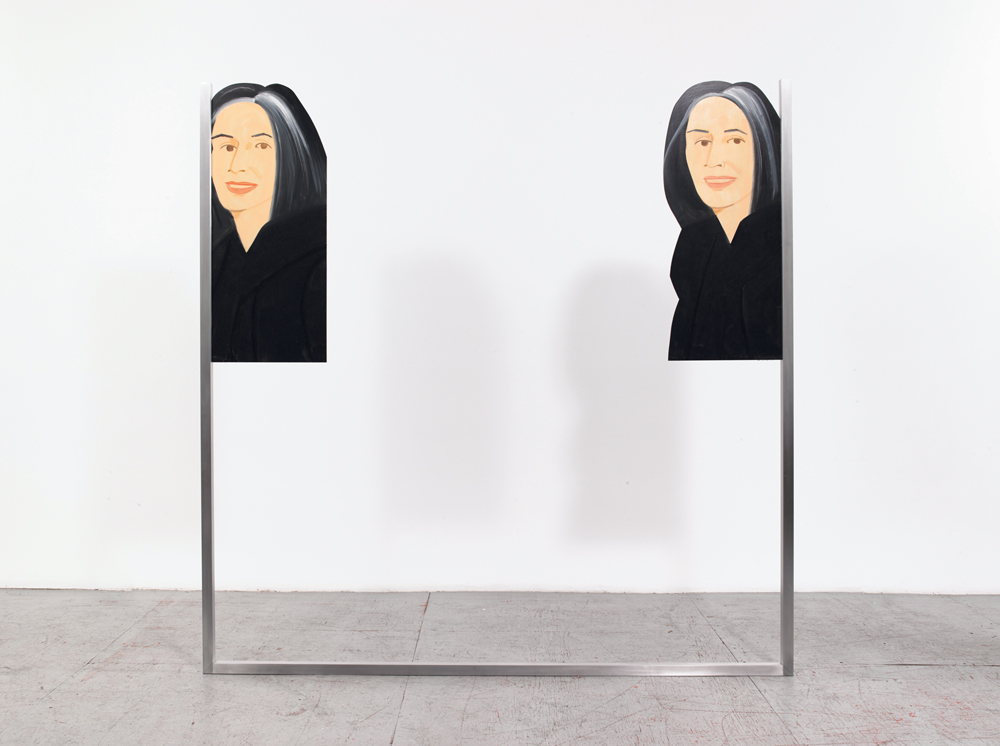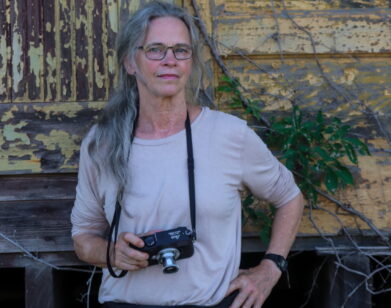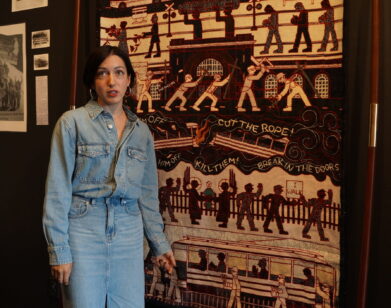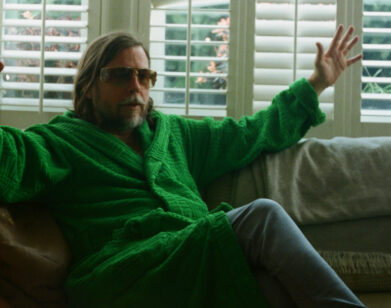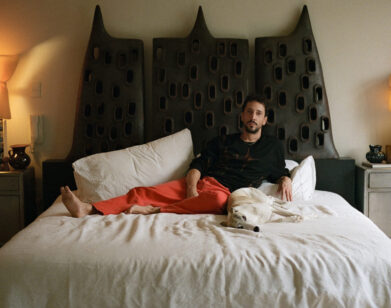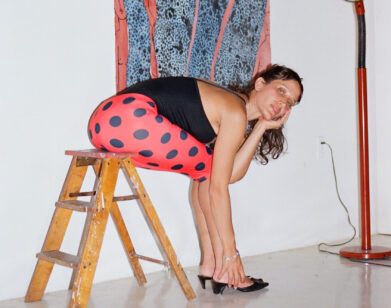Alex Katz
Painting’s always behind the times somehow. I wanted to paint things that were right in front of me, so it’s now. alex katz
One night this past February, artist Alex Katz held a small, informal gathering at his SoHo studio, displaying a number of recent paintings. Among them was a monumental, blue, gray, and white landscape of winterlike trees. Another was a closely cropped portrait of a woman in a black shirt, her image repeated five times—not in the pop screen-print manner of infinite duplication but in a New Wave cinema split screen of shifting, intimate moments. (There was also a particularly attractive smaller painting of a sheepdog by the entrance.) Katz’s studio, which he moved into in the late ’60s, is one of those rare remaining live-work artist spaces left in the neighborhood—it hasn’t been chopped up or redecorated or besieged by interior designers; it’s just this charming, warm, linoleum-floored loft space that takes up its allotted section of the building. In other words, it feels more like a real room because it hasn’t been obsessively over-thought or reconsidered or diminished by passing fads. Katz’s work isn’t so different.
Like any master, the 88-year-old artist developed a signature style with paint-collapsed space; flattened, abridged subjects; bright, antic colors—that is immediately identifiable as a Katz and yet also manages to exist in some reality outside of time or trends. He is a self-proclaimed seeker of the Now, but I’d argue he’s more of a conjurer of the eternal present. His landscapes and portraits remind me at once of personal photo albums in the loose, cropped way they capture the sincere, temporal moment, and Japanese wood-block prints in their highly edited and sweeping eternal imagery. It also isn’t a surprise to think of him more in terms of New York School poets like Frank O’Hara rather than his painterly pop or abstract expressionist contemporaries—poetry transcends where painting tends to remain confined to its movement and place. That doesn’t mean Katz has stopped experimenting. Ever inspired by media, he has recently been using photos snapped on his iPhone as source material.
This summer, he has three shows in the works, starting this month with Gavin Brown’s Enterprise, where he’s showing new works on paper; an exhibition opening in June at the Serpentine Gallery in London, which will include sculptural outdoor cutouts of bathers made from porcelain; and another show starting in June at the Center for Maine Contemporary Art, which involves 52 small paintings on board that the artist created en plein air at and around his summer home.
Artist Rob Pruitt visited Katz in his SoHo apartment to talk about his life, work, interest in fashion, and fearlessness when it comes to his paintings matching furniture. If Pruitt’s memory holds true, the two artists first met 17 years ago when Pruitt invited him to sell something at his first flea market at Gavin Brown’s gallery; Katz chose coffee mugs with a painting he had done of his wife, Ada. –Christopher Bollen
ROB PRUITT: Tell me about your daily routine. Does it change from season to season?
ALEX KATZ: There’s a pretty big change soon because I go up to Maine for three months in summer. I started going up there in my twenties. In the city, I wake up, do calisthenics, run, and get the paper. In the country, I wake up, eat breakfast, and go to work.
PRUITT: So you forgo calisthenics in the country?
KATZ: Oh, no! I do the calisthenics in the country, too. But I don’t run. Also, I take a bath in the city. But in the country, I take a shower in the afternoon. That’s a big difference. [laughs]
PRUITT: What kind of calisthenics do you do?
KATZ: It varies a little bit. I was athletic when I was young. I worked at a job for ten years carving frames, which was very physical. Then when I became a visiting critic at Yale, I just stopped doing the physical stuff. I was also hanging out a lot in bars. By the time I was in my thirties, I wasn’t feeling so hot. So I stopped going to the bars and started going to the gym. I stopped smoking, too. I did swimming, running, and basketball on different days. In my forties I did serious running. I started having injuries in my fifties, so I slowed from running to jogging, which doesn’t put any strain on the legs. Now in the morning, I stretch and do push-ups and sit-ups for my main exercise. And I run a block and then sprint a block.
PRUITT: I’m the opposite from you. I hate to be sporty and athletic. I wish that I could be, but I just wasn’t born that way.
KATZ: I was raised in Queens. It was the beginning of the suburbs. There were a lot of athletic boys there, and I grew up with these guys. I played ball all the time. Then there were these two artists I knew who weren’t athletic. They were really interesting. And then there was this other guy, I don’t know if he was gay, but he was effeminate. He liked plays and wanted to be a baton twirler.
PRUITT: [laughs] See, that was me, but too uncoordinated to twirl.
KATZ: I went to plays with him. So I actually had this really nice balance growing up. One of the artists, his father went down in a ship during the war, and he dropped out of Pratt to support his family and started an interior design business. He gave me books on Mondrian. And he was working on a catalog and asked me, “Why don’t you illustrate it?” I was 16. He was 19. So we bought an airbrush, and I made these illustrations for him. The other artist friend would have given Andy Warhol competition. He was flat-out brilliant. He dropped out of trade school. The teacher asked, “Why are you quitting school? You’re so good.” He said, “‘Cause you have nothing more to teach me.” [laughs] But at 19 he was an art director making a lot of money. He went into the Marines, and when he came out, he got a better job. When I finally met him again, he wasn’t even doing artwork. He said, “I pay people to do that.”
PRUITT: I wonder if he felt he made all the right choices.
KATZ: Well, he felt pretty good. He could do anything.
PRUITT: You two went to the same trade school for art.
KATZ: Yeah. In the trade school, if you show up and sat in your seat, you got an 80.
PRUITT: But Cooper Union, where you went afterward, was more challenging.
KATZ: I came right after the war, and there were a lot of vets that year who were just back and very serious and extremely competitive. A lot of people couldn’t take the tension. Out of the 90 people that started, only 60 graduated. New York was kind of provincial at the time, and Cooper Union was one of the few sophisticated schools.
PRUITT: I know one of your professors was Robert Gwathmey. My husband’s parents have one of his paintings over their fireplace.
KATZ: Oh, yeah. He was heaven. He kept telling me I was an artist. He said, “Listen, Alex, make me a political thing. I’ll put it in my gallery.” But I couldn’t. I hated politics. I was so embarrassed. I could never stand politics.
PRUITT: Did you like art school?
KATZ: Yeah. The happiest time of my life was art school. I didn’t have to work. I had the GI Bill because I was in the Navy for a year. So I was very lucky. And I played basketball for Cooper Union. I won the public speech contest. I had a very pretty girlfriend. [laughs]
PRUITT: You were golden! Life couldn’t be better.
KATZ: I had fantastic aptitude, but I didn’t have any real skills. I just decided that by a year and half into school I was going to pass everyone. And I did. I started to have a hard drive, which continues to this day.
PRUITT: Maybe it’s wrapped up in your athleticism. On the one hand, your paintings look very easy to make, and yet I’m also aware that they require a lot of physical exertion.
KATZ: It’s physical.
PRUITT: That’s why I was asking what your daily routine was. I can lounge around for hours and procrastinate, but you seem like the opposite of that. You seem very focused.
with my painting, the style really is the content. The style holds everything together. What makes everything one is the style. alex katz
KATZ: Yeah. But sometimes it takes me days or weeks to get something clear in my head on what I want to do. Everything is in steps. One thing leads to another. I found early on that I couldn’t paint six hours a day like Bill de Kooning. My painting time was completely different. My talent was different. You have to find what your temperament is like and live around it. I find I work really well off the top of my head because you get the unconscious into it. Otherwise, it’s just an idea. And I’m not so hot there. [laughs] It’s not what I want, you know?
PRUITT: How did you come to art? Were your parents artistic?
KATZ: My mother was an actress. She was on the Yiddish stage actually.
PRUITT: Oh yeah, somewhere close to here.
KATZ: On Second Avenue. But she was knocked off it by my father. She had met him in Russia. It’s kind of a crazy family. They’re part of the people who separated themselves from the Jewish religion and went into the secular world. When my mother was 15, she said, “This town has nothing more to offer me. I want to go to Palestine.” Her parents said, “Sure. Here’s some money. Go.” She goes to Palestine. She had an affair, I think with a painter. She ended up with a lot of paintings. [both laugh] And then she said, “I want to be an actress.” She went to Odessa to study—she says with Stanislavsky, but she lied a lot. I don’t know whether it’s true. Then she said, “I need more psychology.” So she enrolled in the university at Leningrad. But they were saying they were going to get rid of Jews or something. So she took the train back home. Meanwhile, my father came from a family of scholars. They had a big tile factory where they made stoves in Lida. He had property. He said his blood was much too hot to be a rabbi, so he became a playboy. He was very cultured. He used to fool around in Vilnius. The war came and he ended up making an amateur theater with his friends and a soup kitchen for poor people.
PRUITT: They were both very worldly, very broad-minded and educated.
KATZ: Absolutely, backwards and forwards. She had a lot of style, but he had great taste. It all came from the Talmud, which, as I understand it, is all about the right way to do anything. He was also super-physical, very muscular. My mother said she’d never marry a Jew who’s too skinny. And she said about my father, “I thought he was an aristocrat because he changed his clothes three times a day.”
PRUITT: So they weren’t challenged by a son that wanted to be a painter?
KATZ: Well, my mother thought I would have a hard life as a painter. My father thought the highest thing a person could be was an architect. Below that was a painter. So he thought it was much better than being, say, a doctor.
PRUITT: That’s awesome. I think I like your dad. So how did you set yourself apart at Cooper Union?
KATZ: My idea was very simple. When I had my first painting teacher, he did a demonstration, and I told the guy next to me, “If I can’t paint better than him in two years, I’ll eat my paint box.” I was absolutely sure I was going to be better than him. My idea at Cooper Union was to listen to what they’re saying and stay inside the realm of convention. So when I finished, I had a high, sophisticated style of painting and could have gotten a teaching job like everyone else. But instead I went up to Maine and tried to paint outdoors. And it was like, “Bingo!” So I threw that whole other side away. In fact, I have one of my early plein air paintings over there. [points to a small gray painting next to the window] That’s from 1951 or 1952.
PRUITT: The colors are muted but I can still see Alex Katz in that painting, for sure.
KATZ: He’s sort of there. But that kind of painting was completely from Mars at the time I painted it. I thrashed around for about ten years.
PRUITT: Was New York in the abstract expressionist moment yet?
KATZ: Yeah, the beginning. It was right around us and around the school. My friends and I all got involved in that immediately. But I wanted to paint realistically. The other guys, they all wanted to be abstract. But when you start with realistic, it’s like opening Pandora’s box. You say, “What is realistic?” I was after something I wasn’t seeing in paintings, an immediacy of perception. It took a while. I was also working unconsciously, just letting it fly. I liked the way I was doing it. I was painting from photographs, too. It wasn’t the subject matter so much; it was the way I was painting that interested me. I might have told myself it was the subject matter, but it wasn’t.
PRUITT: How would you characterize the way you were painting?
KATZ: I’d do a painting a day usually. I think I destroyed about a thousand paintings by the end of my twenties. With the early ones, I wanted it to look really fresh. So first it would be a dash. And then you look at them and do touches here and there. As I got older, it became more direct.
PRUITT: When do you think you tapped into what we now regard to be an “Alex Katz painting”?
KATZ: I felt they were me all along. The collages I made around 1955 were real art. The paintings were more problematic. People say that I put it together in about 1957 or ’58; that’s when the work became more like a signature. But when you’re doing it, you don’t know what you’re doing. [laughs] Because you don’t have much to hook into.
PRUITT: When you’re young, it’s like you’re running through this maze, grabbing things that you might need in your tool bag, throwing things away that aren’t essential, and hopefully, your thoughts are getting clearer, but you don’t really know what you’re doing.
KATZ: If you know what you’re doing, you’re doing dull stuff.
PRUITT: You get called a quintessential American artist a lot, as if what you paint is particularly American.
KATZ: It’s usually the case that painters paint with the previous generation’s look. Painting’s always behind the times somehow. I wanted to paint things that were right in front of me, so it’s now. And another thing is, the abstract expressionists had that thing of, subject matter becomes content, content becomes form. And I always thought there was no room for style. I felt with my painting, the style really is the content. The style holds everything together. What makes everything one is the style. The high school I went to had two things to offer: It was all about style and clothes. [laughs] And, as I said, my parents were into style, and so were my friends. And don’t forget I did costumes for Paul Taylor [the pioneering choreographer] for nearly 30 years as well. I have no problem making costumes. Painting can be so stuffy, and it always feels like the past tense.
PRUITT: But incorporating an awareness of style in the paintings gives them a kind of electricity and holds them together. It can plug you into the moment at which they were made. And yet weirdly there is nothing necessarily dated about your paintings.
KATZ: Somehow! It’s kind of amazing to me.
Pop art is pretty much all graphic art, you know . . . My thing was more turned towards traditional painting. alex katz
PRUITT: When people think about fashion in the ’70s, for example, they think about these things that look rather silly at this point. But when I look at six decades of your paintings, there’s a classic style that rises above trends.
KATZ: I think I’ve been lucky, because I just was trying to paint the now all the time.
PRUITT: I think you might just be a terribly elegant person. Like the things you train your eye on are sleek and beautiful and wonderful.
KATZ: There’s enough dreary stuff in the world. And there’s a good audience for dreary stuff. But that’s not what I want.
PRUITT: Out of curiosity, why have you never made a still life?
KATZ: I did in the beginning. But Picasso and Matisse were the guys I wanted to get away from, and cubism is all still lifes. Their paintings are all closed drawings. And still life is a perfect form for that. By the mid-’50s, I sort of dropped the still life. The large picture was a way of getting around them, too. The abstract expressionists were also into the large form because it was a way of getting around Matisse and Picasso. Picasso can’t paint big paintings. Matisse didn’t bother after a certain point.
PRUITT: But the painting that Picasso is best known for is a big painting.
KATZ: Yeah, it’s not so hot, though. [laughs] Guernica is a big graphic to me. I don’t think of it as a great painting.
PRUITT: I guess it is kind of like a blown-up collage.
KATZ: Yeah, it’s a terrific collage, but it’s not a great big painting.
PRUITT: Are you always in the moment? Or are you ever self-consciously aware of your production? Do you ever think to yourself, “It’s time to do something completely unexpected!”
KATZ: Well, actually, you want to go into an area where you’re frightened. Otherwise, you’re just going to be repainting beautiful paintings, but a little duller each time.
PRUITT: That’s such a simple answer, but it’s absolutely true, at least from my perspective.
KATZ: You have to be a little scared of what you’re doing. Otherwise, you just paint the same masterpiece a little worse. Like, Clyfford Still was out of sight for about four years and then he kept repeating himself until it wasn’t that interesting.
PRUITT: A lot of people have talked about your work in relation to cinema.
KATZ: Yeah. I thought popular culture was how you made fresh images. First, I started looking at photographs. And TV was amazing to me; you could take a 12-inch screen and get it to dominate a room. And then wide-angle movies. When I worked in a frame shop, I’d go to a movie after work, like a Western that would have a big head on one side and a plain on the other. I’d never seen a painting like that. And I liked big billboards, too. All of these things gave me new images.
PRUITT: And new ways to compose a picture.
KATZ: Yeah, and give some life to it. And a lot of it was problematic.
PRUITT: I’ve seen pictures of your house in Lincolnville, Maine. It’s painted this very vivid color.
KATZ: Yeah, bright yellow.
PRUITT: Has it always been that color?
KATZ: No, it was peach and white when we got it. It was like a lovely house that a little old lady would come out of and hand you cookies. I decided to paint it mustard, one of the three original colors of casein paint—which is blue, red, and yellow. It’s paint made from milk protein and pigment.
PRUITT: I wanted to ask that question because, being here in your studio, which is also your home, I’m noticing it’s not a place that gets remodeled often. For instance, I don’t see a subzero refrigerator, or those signifiers that a lot of Americans take into their lives.
KATZ: We hide the refrigerator. [Pruitt laughs] It’s in that room over there.
PRUITT: Because it’s an unsightly box.
KATZ: Yeah, they’re pretty ugly, the kind of Americana that’s forced on the public that I find a bit disgusting. It took me ten years to figure out the vent over the stove. But once you get something you like, there’s no point to change it.
PRUITT: It seems like you live your whole life that way. But constant change is part of the American culture for most people.
KATZ: They like change. If they have some money, they change their whole interior around.
PRUITT: They’re itching to get the next best thing. Consuming is an endless treadmill. Here’s an arbitrary question: Can you tell me about painting seagulls [for Katz’s 2000 painting Seagull]?
KATZ: How do you do a bird in flight? That was part of the question. I had Vivien [Katz’s daughter-in-law] take a movie of a seagull flying and break it into stills. Then I put the stills together like a Renaissance painter would to get motion. The seagulls look simple, but they’re not. A couple of them really have flight in them. And the seagull is such a romantic image, and it has freedom in it. Except to Vincent [Katz’s son] who grew up with seagulls, and they’d take the hamburger out of his hands.
PRUITT: They’re such scavengers. Do you think you’re a pop artist?
KATZ: No, I’m a predecessor, I’m a precursor. I mean, Andy Warhol and Tom Wesselmann and even Marisol couldn’t do what they do unless they saw my work. I was very popular. I was on top of the bubble in the late ’50s. But my work relates less to subject than theirs does. It relates to historic painting. I’m a traditional painter. You can look at my paintings and think Renaissance paintings and stuff like that. It’s more traditional.
PRUITT: Also Warhol and the like were painting these superlative moments, headlines, like Jackie at the funeral. Those are potent moments. In your paintings, I don’t see potent moments. I see life being lived.
KATZ: And the references are more complicated.
PRUITT: I see a community of people—family and seasons changing and the elegance and the poetry of one life as the days pass.
KATZ: I wanted to do that. Life passing, and Ada getting older and Vincent growing up and stuff like that. And one of the things is that pop art is pretty much all graphic art, you know? Again, my thing was more turned towards traditional painting.
PRUITT: Your framing has a very strong graphic quality, like a cinematographer or a film director.
KATZ: Absolutely. I’m traditional in terms of the imagery and brushstroke and color.
PRUITT: Tell me about these new sequential figures that you’re doing.
KATZ: They sprung up; I was using my iPhone.
PRUITT: But in terms of the repeating figure, I see a seed of these paintings in another painting from 1960 called The Black Dress.
KATZ: Yes. The repeats I started in the late ’50s. And I’ve been doing repeats ever since. They say if you keep doing repeats, you’re just repeating yourself. So I had to figure another way of doing them. And this is another way.
PRUITT: Also there’s your new painting over there [Tits, a painting of the breasts and torso of a model repeated over and over]. I’ve never seen the breast as a motif dealt with like this. It’s totally …
KATZ: Bananas!
PRUITT: But it’s also very loving and respectful. I could really live with that as something I looked at every single day.
KATZ: I say it would be great over a big couch. [both laugh] I hate to call a girl in and just paint the breasts and let the head go. And this girl I was painting with is just marvelous.
PRUITT: You have a number of paintings around the studio from different decades. I’m sure every studio visit must feel like people are trying to pry things away.
KATZ: Well, a guy came in recently wanting one of the paintings. I said to him, “Listen. You have to give me something that will replace it.” That’s the end of the conversation.
PRUITT: [laughs] I do this weird thing in regard to my own work … Perhaps I should describe it as a kind of schizophrenia. Sometimes I feel like it’s made by this “other Rob,” and I don’t really see the work as mine. That other, thinner Rob.
KATZ: Well, it’s hard to see yourself. Other people tell you what you look like.
PRUITT: I also always have the feeling that I just started yesterday. Maybe it’s so that if people try to push me over into the category of not being a major success, I can think to myself, “Well, of course I’m not. I just started!”
KATZ: That’s the way I feel.
PRUITT: Even though it’s actually been 25 years!
KATZ: That’s pretty much how I always felt, that it was all ahead of me.
PRUITT: But you have so much work to be proud of. And you’re not one to rest on your laurels.
KATZ: No. But you never know who your audience is. A lot of times, I feel there’s no one out there—very little, anyway, except some old friends. But I realize my position in the world has changed a great deal from what it was 40 or 50 years ago.
PRUITT: The art world loves to throw things out and bring new things in. There’s always this new circle of artists entering every five years.
KATZ: That’s right. There’s a new circle. They think differently. I met a young painter recently, and she says, “I hate Andy Warhol.” And I go, “Oh, she’s right for the time.” [laughs]
PRUITT: Of course she should hate Andy Warhol. And then in ten years there will be a group of artists who won’t even know who Andy Warhol is.
KATZ: Well, who knows? It just has to do with the times changing. Some people get swept to the side. Some people come up and go over you.
PRUITT: Right. I’ve seen many people who I started with, who were incredibly talented, yet they’ve fallen to the side. Even if you look at any previous Whitney Biennial catalog, a lot of the names there are no longer part of the conversation today.
KATZ: It has to do with several factors. It has to do with the failure of an audience. A New York audience generally likes decorative paintings, and decorative paintings go with the couch. If you change the couch, you change the painting. [both laugh] And when you’re coming up, and the paintings aren’t first-class decoration, you’re at a disadvantage for publicity and sales.
PRUITT: Yeah. And first-class decorations really cycle.
KATZ: Some hang around a bit longer. Like Twombly and Warhol, absolutely fabulous decorators from day one. When I think of Goya’s tapestries, that’s first-class decoration. I mean, my decorative sense is pretty good, but I’m not close to Warhol. Rothko and Bacon are also great decorators. There’s not much inside, right? Frank Lloyd had a living room in the tropics, and he had a Rothko on one wall and a Bacon on the other. It was divine. With wicker furniture.
PRUITT: That I would like to see. Well, I guess that’s it unless there’s anything you’d like to conclude with.
KATZ: No, that’s enough.
PRUITT: I was a little nervous when I agreed to do this because I have so much respect for you.
KATZ: Well, you did a very interesting job. And in a sense, you and I compete for the now. Most contemporary artists are behind the bubble in time. They’re making videos that are so incredibly boring compared to a good movie. Or they’re making work where I say, “You realize minimal art is 50 or 60 years old?” [laughs] That’s what I tell people to shock them. They just blanch. But we started with a different idea. And when people see the work in ten or twenty years, they’ll think it’s brand new. Because you’re out there in thin air.
ROB PRUITT IS AN ARTIST BASED IN NEW YORK.

